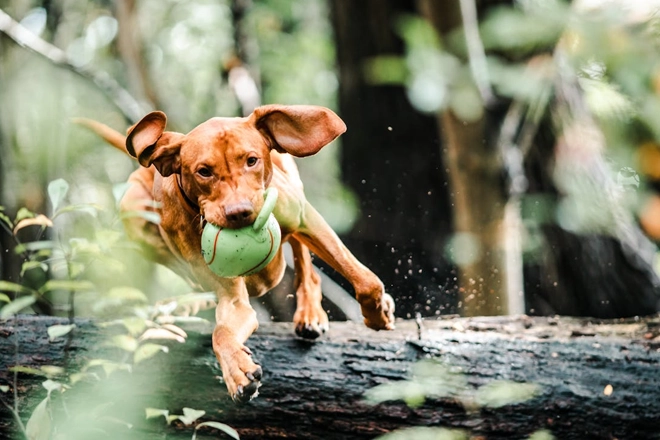For the Purrbabies


Every dog has different exercise needs. Here’s how to keep high-energy pups physically and mentally fulfilled.

Some dogs just don’t stop moving, and that’s not a bad thing. But high-energy dogs often need more than a quick walk or backyard playtime to stay balanced. So whether you’ve got a working breed with endless drive or a mixed pup who’s always ready to play, their physical and mental needs deserve extra attention. The good news? With the right strategies, even the busiest pups can feel fulfilled without running you ragged.
Some dogs were simply built to move. Whether it’s the herding drive of a Border Collie or an energetic mutt, high-energy dogs need more than a daily walk around the block. But that doesn’t mean you need to become a marathon runner overnight. With the right mix of physical and mental outlets you can help your dog stay balanced and happy.
Walks are the baseline activity for any dog, but active breeds may need up to two hours of movement daily. If you’re short on time, consider combining a morning jog with an evening play session. For those dogs that seem to be never ending in their energy, having them join you while cycling or rollerblading can tire them out. There’s also dog treadmills, which can help burn off excess energy.
If you’re not able to dedicate ample time to exercising your dog, or you just want to give them an extra break from the lounging, you can also hire a dog walker, send your dog to doggy daycare, or enroll them in agility programs
For dogs with endless energy, food is more than just fuel. It’s an opportunity for stimulation. Swapping the regular food bowl for puzzle feeders or snuffle mats engages your dog’s brain and taps into natural foraging instincts. You’re helping them slow down and stay focused, plus it burns energy all at once, with zero extra time on your part.
You can also rotate enrichment tools to keep things interesting. These small changes turn daily routines into subtle challenges and are especially helpful for rainy days or when outdoor exercise isn’t possible.
Training sessions aren’t just about obedience (though that’s a great benefit of them). They can also be a powerful mental outlet. High-energy dogs are often highly intelligent, and learning new commands or skills keeps their brains busy. Whether you’re working on the basics or teaching fun tricks like spin, bow, or roll over, the act of learning itself is tiring in the best way.
But you should be consistent with it. Make training a part of your daily routine. A five-minute training session before dinner or a refresher walk with “sit” and “stay” can add structure and help your dog stay sharp.
Some dogs were born with jobs to do. Herding breeds might crave fast movement and problem-solving, while scent hounds tend to come alive when using their noses. Instead of fighting these tendencies—or getting annoyed by them—work with them.
If your dog’s breed is a mystery, pay attention to what excites them. Do they chase squirrels? Hide their toys? Bark at new smells? Observing how they play can give you clues about what kind of enrichment they’ll enjoy most, and how to make the most of their energy.
Not every day has to be action-packed. When bad weather, illness, or a packed schedule get in the way, use simple indoor activities to keep your dog engaged. Hide treats under cups for a shell game, scatter kibble in a blanket for a digging challenge, or play a low-stakes game of hide-and-seek.
Not every dog enjoys going to the dog park, but structured social time with other dogs can be a huge outlet for energetic pups. Playdates with known, friendly dogs give them a chance to run, wrestle, and learn canine manners. Not only that, but socialization is so important in helping reduce behavioral issues in your dog since they observe and are taught by other dogs around them.
If your dog is bouncing off the walls when you’re trying to sleep or log onto a work call, consider shifting what time they exercise. High-energy dogs tend to settle better when they’ve had a chance to burn off steam. A long walk or training session in the morning can help prevent restlessness during the workday. You may also consider calming supplements, but never give your dog a supplement without first speaking to your vet.
Just be mindful of your dog’s ideal wind-down window since not every pup can go immediately to sleep if riled up late at night. With consistency, you’ll start to learn what schedule helps your dog stay calm and content.
Taking care of a high-energy dog can feel overwhelming, especially if your schedule or physical ability makes long exercise sessions hard. Asking for help when you need it is a sign of commitment, not failure. Dog walkers, pet sitters, and local daycares can help share the load.
These pups tend to be smart, enthusiastic, and incredibly loving. They just need structure and outlets for all that excitement. By tailoring activities to their instincts and using a mix of exercise, enrichment, and support, you’ll set your dog up to thrive.
Daily structured exercise, enrichment, and training tend to be the most important with high energy dogs. They prioritize physical and mental outlets for your dog to prevent boredom-based behaviors like chewing, barking, etc.
Yes, but it may require planning. If you work full-time in the office, consider hiring dog walkers, daycare, or investing in enrichment toys while you're away. Early morning and evening activity when you’re home is key.
Most dogs mellow out between 2–4 years old, but it varies by breed and individual. Regardless of age, all still need stimulation and don’t outgrow the need for exercise.
Many dogs go through an adolescent “teen” phase between 6–18 months. Expect testing boundaries, bursts of energy, and a need for consistency. Be patient with them during this time and try to avoid yelling or punishment as they learn and grow.








